 W
WBeezus and Ramona is a 1955 children's novel written by Beverly Cleary. It is the first of Cleary's books to focus on Ramona Quimby and her sister Beatrice, known as Beezus. Beezus and Ramona is realistic fiction, written from nine-year-old Beezus's point of view, as she struggles to get along with her four-year-old sister. Eventually becoming the first book of the Ramona series, it was originally illustrated by Louis Darling; later editions were illustrated by Alan Tiegreen and then by Tracy Dockray.
 W
WDear Mr. Henshaw is a juvenile epistolary novel by Beverly Cleary and illustrator Paul O. Zelinsky that was awarded the Newbery Medal in 1984. Based on a 2007 online poll, the National Education Association listed the book as one of its "Teachers' Top 100 Books for Children."
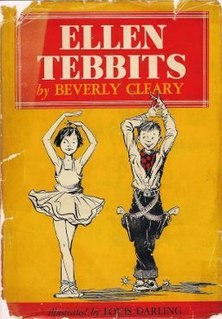 W
WEllen Tebbits is a 1951 children's novel written by Beverly Cleary. It is Cleary's second published book, following Henry Huggins. This humorous realistic fiction story tells the adventures of young Ellen and the new girl in her school, Austine Allen.
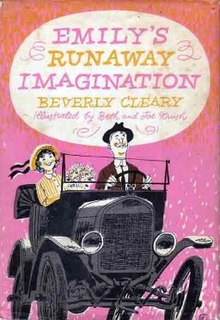 W
WEmily's Runaway Imagination is a children's novel by American writer Beverly Cleary, first published in 1961. Set in the 1920s, the plot revolves around the experiences of a young, imaginative girl named Emily.
 W
WFifteen is a juvenile fiction novel written by Beverly Cleary. It was first published in 1956. It chronicles the perspective of a teenage girl entering her first romantic relationship. The book captures the innocent spirit of life in the 1950s, both through the playfully light storyline and the casual references to convertibles, sweaters, "meeting boys", and soda shops. Regardless, the book remains in print today because its overall theme of difficult adolescent feelings still connects with young readers.
 W
WHenry and Beezus is the second book in the Henry Huggins series. This humorous children's novel was written by Beverly Cleary and published in 1952. Henry comes up with many ways to earn money for the new red bicycle he wants, but they all seem to end up with him in trouble. Finally his friend Beezus gives him an idea that actually works.
 W
WHenry and Ribsy is the third book in the Henry Huggins series of humorous children's novels written by Beverly Cleary. Henry's dad has promised to take him salmon fishing on one condition – he has to keep his dog Ribsy out of trouble for two months. That's not easy to do, especially when Ramona Quimby gets involved. First published in 1954, Henry and Ribsy was originally illustrated by Louis Darling.
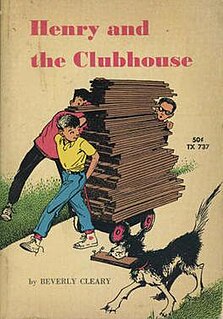 W
WHenry and the Clubhouse, by Beverly Cleary, is the fifth book in Henry Huggins series. Now that he has the paper route he wanted so badly in the previous book, Henry and the Paper Route, Henry finds that it's harder than he expected. His earnings are going for the clubhouse he and his friends are building. One of the boys insists that it be a "Boys Only" club, and that causes trouble with Henry's friend Beezus Quimby and her little sister Ramona. Henry and the Clubhouse was published in 1962.
 W
WHenry and the Paper Route is a book of Henry Huggins series that was written by Beverly Cleary and illustrated by Louis Darling. It was written in 1957 and focused on the main character Henry Huggins' attempts to get a paper route, despite his young age.
 W
WHenry Huggins is the first book in the Henry Huggins series of children's novels, written by Beverly Cleary. Henry is an ordinary boy who manages to get into funny scrapes with his dog, Ribsy. First published on September 6, 1950, it was originally illustrated by Louis Darling and later by Tracy Dockray. It has been translated into Bulgarian, Chinese, Danish, Dutch, Finnish, English, Hebrew, Japanese, Norwegian, Spanish, and Swedish, and published as audio books read by Barbara Caruso and Neil Patrick Harris.
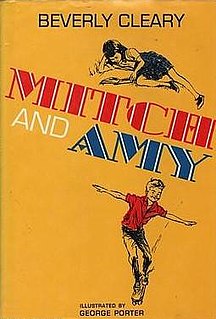 W
WMitch and Amy is a children's novel by Beverly Cleary, illustrated by George Porter, Bob Marstall, Alan Tiegreen, and Tracy Dockray, first published in 1967. It has been translated into Bulgarian and published as an audiobook narrated by Kathleen McInerney.
 W
WThe Mouse and the Motorcycle is a children's novel written by Beverly Cleary and published in 1965. It is the first in a trilogy featuring Ralph S. Mouse, a house mouse who can speak to humans, goes on adventures riding his miniature motorcycle, and who longs for excitement and independence while living with his family in a run-down hotel.
 W
WMuggie Maggie is a book written by Beverly Cleary that was published in the year 1990 revolving around the experiences of eight-year-old Maggie Schultz, and her refusal to learn cursive writing. It has been illustrated by Kay Life, Tracy Dockray, and Alan Tiegreen, and published as audiobooks narrated by Kate Forbes and Kathleen McInerney. It has been translated into Spanish by Ana Cristina Werring Millet.
 W
WOtis Spofford is a 1953 children's novel by Beverly Cleary.
 W
WRalph S. Mouse is the third in a children's novel trilogy by Beverly Cleary. It features Ralph, a mouse with the ability to speak, but only with certain people, who tend to be loners. It was first published in 1982, illustrated by Paul O. Zelinsky.
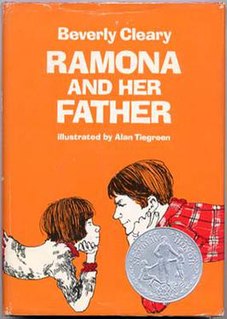 W
WRamona and Her Father is the fourth book in Beverly Cleary's popular Ramona Quimby series. In this humorous children's novel, Mr. Quimby loses his job and Ramona thinks up ways to earn money and help her family out. Published in 1977, Ramona and Her Father was a Newbery Honor Book.
 W
WRamona and Her Mother by Beverly Cleary is the fifth book of the popular Ramona series. Mr. Quimby has found another job, though it is one he does not like very much. Ramona finds herself caught between being too young to stay home alone and too old to enjoy playing with pesky Willa Jean. She is trying to grow up, but sometimes it seems like her family is making it harder. Ramona and Her Mother won the 1981 National Book Award.
 W
WRamona Forever is a humorous children's novel written by Beverly Cleary. The seventh book in the Ramona Quimby series, it continues the story of Ramona, her older sister, Beezus, and their family. They are finally old enough to stay home together, and they work hard to get along. Mrs. Quimby is pregnant and Aunt Bea gets engaged in a book that sees Ramona coping with growing up. It was originally published in 1984.
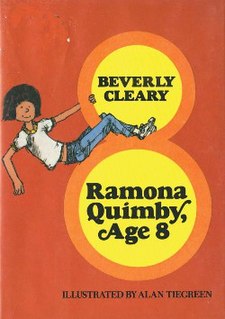 W
WRamona Quimby, Age 8 (1981) is a novel by Beverly Cleary in the Ramona series. Ramona Quimby is in the third grade, now at a new school, and making some new friends. With Beezus in Jr. High and Mr. Quimby going back to college, Ramona feels the pressure with everyone counting on her to manage at school by herself and get along with Willa Jean after school every day. Ramona Quimby, Age 8 was named a Newbery Honor book in 1982.
 W
WRamona the Brave is a children's novel written by Beverly Cleary. It is the third book in the Ramona series, and follows Ramona Quimby and her classmates going into first grade. Ramona the Brave was first published in 1975, seven years after Ramona the Pest. It was originally illustrated by Alan Tiegreen.
 W
WRamona the Pest, by Beverly Cleary, is the second book of the Ramona series and the first to focus on Ramona Quimby as the protagonist. This children's book chronicles the adventures of Ramona's first few months at kindergarten. The book's title is derived from the characterization of Ramona as a "pest" by many, including her older sister Beatrice, known as "Beezus." Ramona the Pest was first published in 1968 and featured illustrations by Louis Darling. Other illustrators have since updated Ramona the Pest, including Alan Tiegreen, Tracy Dockray, and Jacqueline Rogers.
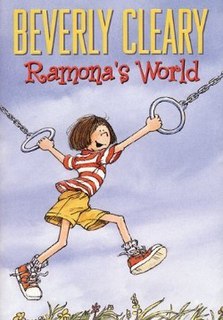 W
WRamona's World is the eighth book in the Ramona Quimby series by Beverly Cleary. Ramona and her sister Beezus are growing up. Ramona is in the fourth grade now, and for the first time she has a best girl-friend, Daisy Kidd. At home she tries her best to be a good role model for her baby sister Roberta, but finds baby sitting harder than she expected. Published in 1999, Ramona's World was written fifteen years after its predecessor, Ramona Forever. It was the last published installment in the series, as well as the last book Cleary published before her retirement.
 W
WRibsy is a children's book by Beverly Cleary. It is the sixth and final book in the Henry Huggins series. Henry plays a minor role in the story, however, as the narrative focuses primarily on his dog, Ribsy.
 W
WRunaway Ralph is the second in a children's novel trilogy written by Beverly Cleary. First published in 1970, it is the last book by Cleary that Louis Darling illustrated before his death. The book features the titular character, Ralph S. Mouse, a house mouse that can talk to humans, and goes on adventures in his miniature motorcycle.
 W
WSister of the Bride is a 1963 young adult novel by Beverly Cleary.
 W
WSocks is a children's novel written by Beverly Cleary, originally illustrated by Beatrice Darwin, and published in 1973. It won the William Allen White Children's Book Award. The title character of the book would eventually become the name for Socks Clinton, the cat of U.S. President Bill Clinton and family.
 W
WStrider is an epistolary novel by children's author Beverly Cleary, the sequel to her Newbery Medal-winning novel Dear Mr. Henshaw. It was first published in 1991; and like Dear Mr. Henshaw, it was illustrated by Paul O. Zelinsky.